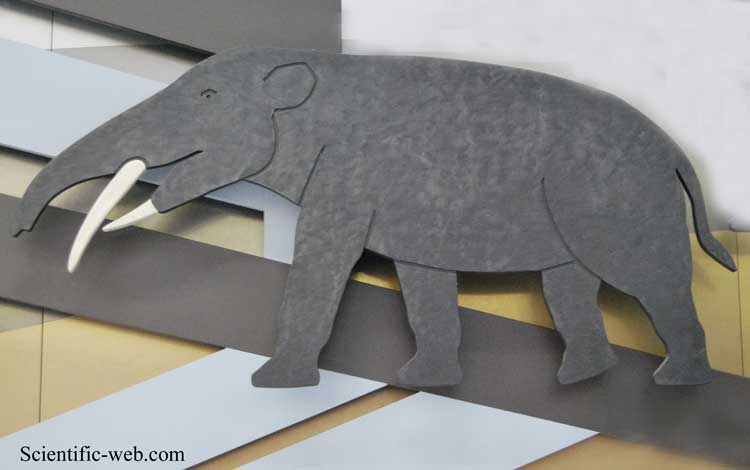Gomphotherium Cladus: Eukaryota --------- Gomphotherium (pronunciation: gom-fo-THEER-ee-um) ("Welded Beast") is an extinct genus of proboscid which evolved in the Early Miocene of North America from 13.650—3.6 Ma, living about 10 million years. The genus emigrated into Asia, Europe and Africa after a drop in sea level (probably during the Tortonian epoch) allowed them to cross over.[1] It survived into the Pliocene, and its remains have been found in France, Germany, Austria, Kansas, Pakistan and Kenya. Gomphotherium, also known by synonyms such as Trilophodon, Tetrabelodon, or Serridentinus, stood around 3 metres (9.8 ft) high, and bore a strong resemblance to a modern elephant. However, it had four tusks; two on the upper jaw and two on the elongated lower jaw. The lower tusks are parallel and shaped like a shovel and were probably used as such. Unlike modern elephants, the upper tusks were covered by a layer of enamel. Compared to elephants, the skull was more elongated and low. These animals probably lived in swamps or near lakes, using their tusks to dig or scrape up aquatic vegetation. In comparison to earlier proboscids, Gomphotherium had far fewer molars; the remaining ones had high ridges to expand their grinding surface. A complete skeleton of Gomphotherium has been found at Mühldorf, Germany, in 1971. Taxonomy Gomphotherium was named by Burmeister (1837). It is not extant. It was considered paraphyletic by Lambert (2007). It was assigned to Gomphotheriidae by Burmeister (1837), Qiu et al. (1981), Carroll (1988), Lambert and Shoshani (1998), Sach and Heizmann (2001), Sanders and Miller (2002) and Lambert (2007). Serridentinus was named by Osborn (1923) and synonymized subjectively with Gomphotherium by Tobien (1972),[2] Madden and Storer (1985),[3] Shoshani and Tassy (1996)[4], Lambert (1996), Lambert and Shoshani (1998)[5] and Christiansen (2007). References 1. ^ Alberdi, M. T.; Prado, J. L.; Ortiz-Jaureguizar, E.; Posadas, P.; Donato, M. (2007), "Historical Biogeography of Trilophoont Gomphotheres (Mammalia, Proboscidea) Recontructed Applying Dispersion-Vicariance Analysis", in Díaz-Martínez, E.; Rábano, I., Proceedings of the 4th European Meeting on the Palaeontology and Stratigraphy of Latin America, Zaragoza Spain 17-19 September 2007, Madrid: Instituto Geológico y Minero de España, pp. 9–14, ISBN 978-84-7840-707-1, http://www.igme.es/4empsla/libro/02.pdf, retrieved 2008-07-28 * http://www.elephant.se/gomphotherium.php Source: Wikispecies, Wikipedia: All text is available under the terms of the GNU Free Documentation License |
|


